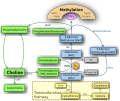- General structural formula of phosphatidylcholines
- Choline metabolism

Phosphatidylcholines (PC) are a class of (glycero)phospholipids that incorporate choline within the headgroup. They are a major component of biological membranes and can easily be obtained from a variety of readily available sources, such as egg yolk or soybeans, from which they are mechanically or chemically extracted using hexane. They are also a member of the lecithin group of yellow-brownish fatty substances occurring in animal and plant tissues. Dipalmitoylphosphatidylcholine is a major component of the pulmonary surfactant, and is often used in the lecithin–sphingomyelin ratio to calculate fetal lung maturity. While phosphatidylcholines are found in all plant and animal cells, they are absent in the membranes of most bacteria, [1] including Escherichia coli . [2] Purified phosphatidylcholine is produced commercially.[ citation needed ]
Contents
- Structure and physical properties
- Possible health benefits
- Senescence
- Lipolysis
- Ulcerative colitis
- Biosynthesis
- Additional images
- See also
- References
- External links
The name lecithin was derived from Greek λέκιθος, lekithos 'egg yolk' by Theodore Nicolas Gobley, a French chemist and pharmacist of the mid-19th century, who applied it to the egg yolk phosphatidylcholine that he identified in 1847. Gobley eventually completely described his lecithin from chemical structural point of view, in 1874. Phosphatidylcholines are such a major component of lecithin that in some contexts the terms are sometimes used as synonyms. However, lecithin extracts consist of a mixture of phosphatidylcholine and other compounds. It is also used along with sodium taurocholate for simulating fed- and fasted-state biorelevant media in dissolution studies of highly lipophilic drugs.
Phosphatidylcholine is a major constituent of cell membranes and pulmonary surfactant, and is more commonly found in the exoplasmic or outer leaflet of a cell membrane. It is thought to be transported between membranes within the cell by phosphatidylcholine transfer protein (PCTP). [3]
Phosphatidylcholine also plays a role in membrane-mediated cell signaling and PCTP activation of other enzymes. [4]





